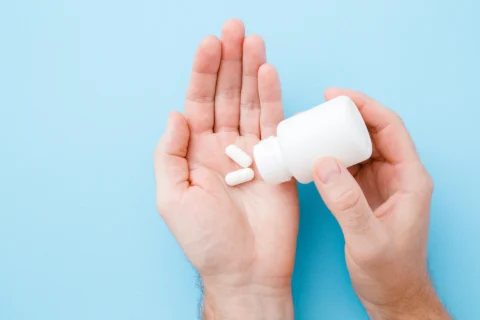Clomiphene citrate, commonly known as Clomid, is a selective estrogen receptor modulator (SERM) that has been used since the 1960s as a fertility treatment for women.
In recent decades, Clomid has also gained popularity among men looking to boost their testosterone levels. But how long does it take for Clomid to work in men? Let’s take a closer look.
About Clomiphene (Clomid): Mechanism of Action
Clomiphene citrate is the generic name for the brand-name drug Clomid. It works by blocking estrogen receptors in the body, which tricks the brain into thinking that estrogen levels are low.
This causes the pituitary gland to release more follicle-stimulating hormone (FSH) and luteinizing hormone (LH), which in turn stimulates the testes to produce more testosterone and sperm.
In women, Clomid is used to induce ovulation. In men, it can help boost low testosterone levels while also increasing sperm production and motility. This makes Clomid an attractive option for treating male infertility.
Why is Clomiphene Prescribed for Men?

Clomiphene is commonly prescribed off-label to men who have low testosterone, typically in conjunction with infertility.
Symptoms of low testosterone in men may include:
- Low sex drive
- Erectile dysfunction
- Decreased energy and fatigue
- Loss of muscle mass
- Increased body fat
- Mood changes like depression
- Difficulty concentrating
Clomiphene can help raise testosterone levels back to normal ranges, helping to alleviate these symptoms. It also preserves or improves sperm production, unlike testosterone replacement therapy which can further diminish fertility.
How Does Clomiphene Increase Testosterone in Men?
In men, Clomid works by blocking estrogen receptors in the hypothalamus, the area of the brain responsible for releasing hormones. This tricks the brain into thinking that estrogen levels are low.
As a result, the hypothalamus steps up the production of follicle-stimulating hormone (FSH) and luteinizing hormone (LH). FSH stimulates the testes to produce more sperm. LH signals the testes to synthesize more testosterone.
By influencing these two key hormones, Clomid can increase sperm production and raise testosterone levels in men with low T.
What’s the Typical Timeline for Clomid to Increase Testosterone?
Most studies show that Clomid can effectively increase testosterone levels within 1-2 months when taken daily at a dosage of 25-50 mg.
However, the timeline can vary from person to person based on factors like:
- Age – Older men may be less responsive to Clomid therapy.
- Baseline testosterone – Men with very low baseline T may take longer to respond.
- Other health conditions – Diseases like type 2 diabetes can impact results.
- Medications – Other drugs the person is taking may interfere.
- Dosage – The dose of Clomid impacts how quickly it takes effect.
According to one study, men taking 25 mg of Clomid daily saw significant increases in testosterone after 4-6 weeks of treatment. But those with very low baseline T below 150 ng/dL took up to 3 months to reach optimal testosterone levels.
When Are Improvements in Sperm Count Seen?

While Clomid may raise testosterone levels within 1-2 months, its effects on sperm production take longer.
Sperm maturation is a 90 day process. So it takes about three months before increased sperm production will show up on a semen analysis after starting Clomid.
Clinical studies have found that:
- Optimal sperm concentration improvements may take up to 9 months of Clomid treatment.
- Positive effects on sperm motility and morphology can take 6-9 months.
- Pregnancy rates start to improve after 9-12 months of therapy.
So while Clomid works relatively quickly to boost T levels, it takes longer to translate into a measurable sperm count, and quality increases. Patience is required.
How Long Should Men Take Clomid Therapy?
Most experts recommend men continue Clomid therapy for a minimum of 3-4 months to allow the drug to raise testosterone levels and improve semen parameters.
If T levels plateau yet sperm count remains low after 4-6 months, continuing Clomid for up to a year may be worthwhile since it can take 9-12 months to realize the full fertility-boosting benefits.
Always work closely with your doctor to determine the ideal length of treatment based on your test results and fertility goals.
Long-term use of Clomid for more than 1 year may further improve pregnancy rates, as demonstrated in some studies. But it’s unclear if this simply reflects its sperm-boosting effects taking over 12 months to fully materialize.
What Factors Influence Clomid’s Effectiveness?
Several factors can impact how quickly and effectively Clomid works to raise T levels and boost sperm production in men:
- Age – Older men may be less responsive.
- Baseline testosterone – The lower it is, the longer it may take to normalize.
- Other medications – Certain medications can interfere with Clomid.
- Dosage – HigherClomid dosages speed up response times.
- Overall health – Chronic illnesses like diabetes may reduce efficacy.
- Genetic defects – Genetic issues causing low T require specialized treatment.
- Damage to the testes – Past damage can blunt Clomid’s effects.
- Duration of low T – Longer duration may slow response.
Working with a knowledgeable physician and customizing the treatment protocol to your specific situation is key to getting optimal Clomid results.
What Are the Side Effects of Clomid for Men?
When used properly, serious side effects from Clomid are relatively uncommon in men. However, possible side effects can include:
- Headaches, dizziness
- Blurred vision, visual disturbances
- Changes in mood – anxiety, irritability, depression
- Breast tenderness or enlargement
- Upset stomach, nausea, vomiting
- Weight gain
- Hair loss
Higher dosages over 50 mg daily may increase the risk of side effects. Seek prompt medical attention if you experience vision changes while taking Clomid.
The Takeaway – How Quickly Does Clomid Work for Men?

In summary, Clomid can raise testosterone levels within 1-3 months in men with low T but may take over 6 months to maximize its sperm-boosting benefits. Exact response times vary based on the individual.
Patience and close monitoring of hormone levels, sperm parameters, and fertility markers are important when using Clomid therapy in men.
Work closely with a doctor who is experienced in using Clomid to treat male infertility for the best chances of success. Consistent follow-up is key to determining when effects are seen and if any dosage adjustments are needed.
While not a quick fix, Clomid offers a relatively safe, convenient way for many men to improve testosterone levels, sperm production, and fertility when taken for an adequate length of time.







